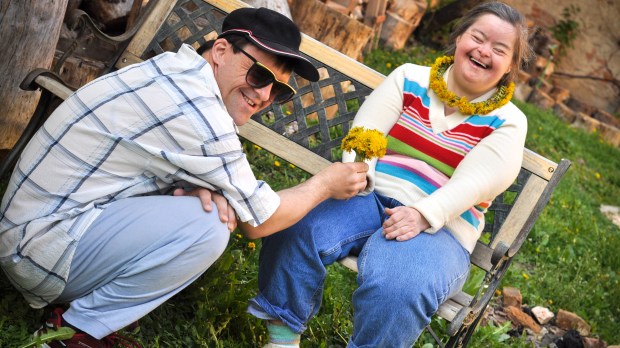Picture this: You’re sitting in your backyard for a summertime cookout, and the man who’s been boarding at your home starts hugging your wife and giving her pecks on the cheek. Your friends are enjoying their burgers and drinks, and no one bats an eyelash.
Or this: the person living upstairs often has trouble getting to sleep at night because he’s afraid of the lions coming out of the walls. You walk down the hall to his room and demonstrably chase the lions away.
Or perhaps your lodger locks himself in your bathroom so he can spend all the time he wants to—and it’s a lot—to wash his hands.
That’s kind of what like is like in Geel, Belgium, a town that for centuries, at the inspiration of a Catholic saint, has tried to integrate people with mental disabilities into everyday life.
National Public Radio stopped in Geel recently to describe how life is these days, but it helps to have a little background. Here is part of the entry from Butler’s Lives of the Saints for May 15, feast of St. Dymphna. It uses an older spelling for the names of the town and the saint:
In the town of Gheel, twenty-five miles from Antwerp, great honor is paid to St. Dympna, whose body, and that of St Gerebernus, [are] buried in ancient marble sarcophagi, were there discovered…in the thirteenth century. Widespread interest was taken in them because the elevation of the relics of St. Dympna was followed, it is alleged, by the restoration to normal health of a number of epileptics, lunatics and persons under malign influence who visited her shrine. Ever since then she has been regarded as the patroness of the insane, and the inhabitants of Gheel have been distinguished by the kindly provision they have made for those so afflicted. As early as the close of the thirteenth century an infirmary was built for their accommodation and at the present time the town possesses a first-class state sanatorium for the care and supervision of mental defectives, the greater number of whom lead contented and useful lives as boarders in the homes of farmers or other local residents, whose they assist by their labour wand whose family life they share.
What the Rev. Alban Butler chronicled in the 18th century is still pretty much the case today, as NPR discovered. In the shadow of the bell tower of the medieval Church of St. Dymphna, Geel residents carry on the 700-year tradition of accepting people with mental disorders into their homes and caring for them.
It isn’t meant to be a treatment or therapy. The people are not called patients, but guests or boarders. They go to Geel and join households to share a life with people who can watch over them.
One of the approximately 250 boarders in Geel today, a 51-year-old Flemish man named Luc Ennekans stays with Toni Smit and Arthur Shouten. Ennekans is a friendly man. In fact, he’s the one who showered Smit with affection, brought her flowers, pecked her often on the cheek and walked arm-in-arm with her, all while Shouten looked on.
“If it were up to Luc, he would be hugging and kissing me all day,” Smit said.
“You couldn’t even give each other a hug or Luc is standing behind us,” Shouten added.
But the couple has had six boarders over the years, each with a unique set of challenges, so they’ve learned how to deal with odd situations. In this case, they encouraged Luc to find a girlfriend.
Like many hosts in Geel, they accept that this is simply who their boarders are. It’s not abnormal or something they need to change. “It’s just normal life,” Shouten says. That acceptance of mental differences has become something of a tradition in Geel. It’s at the heart of the boarder program, and some observers think it’s also responsible for the system’s success. Around the world, many different experiments have been attempted over the centuries to provide humane care for people with mental illness and mental disabilities. Geel is one that has endured.
A public psychiatric hospital in Geel manages the boarder program. After medical professionals perform an evaluation, they pair the boarder with a household, which receives a stipend from the government, training and support. Hospitalization is available if needed, and people who have previously exhibited violent behavior are usually not admitted to the program.
There are a few important criteria for acceptance into the Geel program. The program typically selects patients with severe mental illness or cognitive disabilities who have difficulty living independently. In 2003, almost half of the town’s 516 boarders had a cognitive disability, and over 20 percent carry a diagnosis of schizophrenia or other psychotic disorder, according to research by Jackie Goldstein, a professor emeritus of psychology at Samford University. Some boarders have traditionally had other conditions such as learning disabilities or autism.
With the United States continuing to look for answers to better deal with mental illness, might this experiment be replicated in an American town?

